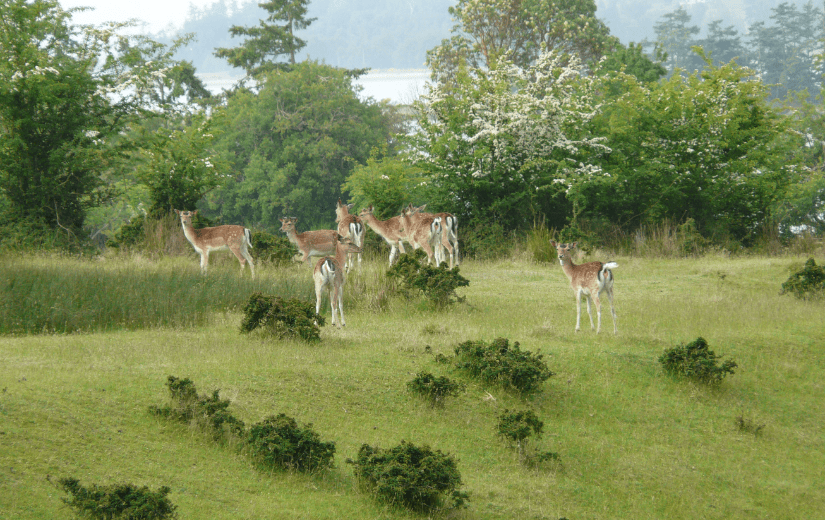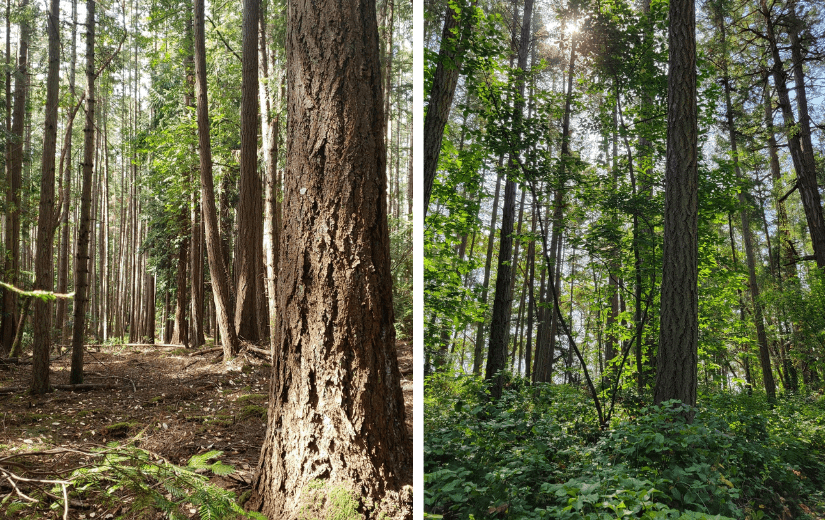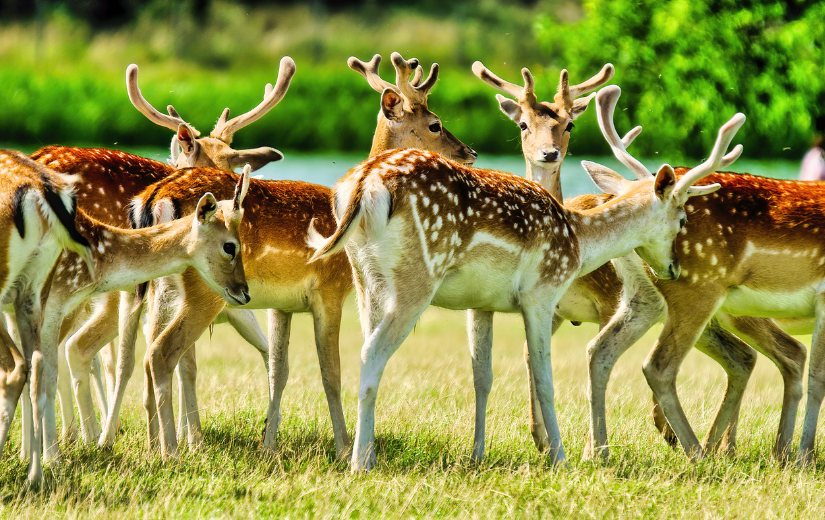Parks Canada has announced the postponement of the Sidney Island Ecological Restoration Project (SIERP). While the decision to proceed with or postpone the project is not the BC SPCA’s, the BC SPCA will continue to advocate for animal welfare and welcomes invitations from all levels of government to consult on projects that impact wild animals.
The BC SPCA has maintained a neutral stance of non-opposition based on reviewing historical activities, scientific evidence and approval of the partners involved for a project that would put an end to the 40+ year cycle of killing fallow deer as well as the ecological restoration and reconciliation goals that would benefit future species return to the island. With the project now postponed, our concerns centre around the fallow deer remaining on Sidney Island and any future efforts to manage the population.
More information can be found below, and on the Parks Canada project webpage. Questions or concerns can be directed to the Gulf Islands National Park Reserve via email at gulfinfo@pc.gc.ca or by phone at 250-654-4000 or toll free at 1-866-944-1744.
Update October 30, 2024:
Since 2017, the BC SPCA has provided feedback as animal welfare subject matter experts for the Sidney Island Ecological Restoration Project (SIERP). The BC SPCA has maintained a neutral stance of non-opposition based on reviewing historical activities, scientific evidence, approval of the partners involved, and criteria defined by the International Consensus Principles for Ethical Wildlife Control.
The BC SPCA has no legal authority to prevent permitted eradication activities from occurring or enforce related complaints, as free-living wildlife are not covered by the provincial Prevention of Cruelty to Animals Act. The BC SPCA’s goal in consulting on this project has been to provide an evidence-based approach and advocate for the humane treatment of animals.
How do the International Consensus Principles for Ethical Wildlife Control apply to the Sidney Island Ecological Restoration Project?
In 2015, a globally diverse group of 20 experts with backgrounds ranging from wildlife control operators, conservationists, animal welfare scientists, veterinarians and academics participated in a forum to develop the International Consensus Principles for Ethical Wildlife Control that were published in the scientific journal Conservation Biology in 2017.
The BC SPCA’s stance on the SIERP is guided by these International Consensus Principles for Ethical Wildlife Control, which require modifying human practices before controlling wildlife; having a justification for control; clear and achievable outcome-based objectives; causing the least number of animal welfare harms to the least number of animals; be generally socially acceptable; involvement of systematic planning; and making decisions to control wildlife when actual harm is being caused, not due to animals being assigned labels with negative connotations. The Sidney Island Ecological Restoration Project satisfies the International Consensus Principles for Ethical Wildlife Control.
How has the BC SPCA’s involvement improved animal welfare?
BC SPCA feedback and recommendations have led to changes in operational plans to improve animal welfare outcomes. For example, live-capture pens that have been used for past culls will not be used, nor will drop nets, Judas animals, or sentinel deer. Professional markspersons and firearms selected for this project were chosen and implemented to improve animal welfare.
As Phase 2 of the SIERP begins, fencing to establish zones on Sidney Island and the use of scent-indicating dogs will commence. BC SPCA feedback and recommendations include monitoring fencing daily to minimize the risk of, and to mitigate, any potential animal entanglement. Additional considerations including breeding seasons, nest monitoring and access to known wildlife corridors have also been implemented to minimize any impact on non-target wildlife. Other recommendations made by the BC SPCA that have been incorporated into operational plans include establishing protocols in the event non-target wildlife are impacted.
Scent-indicating dogs used during Phase 2 will track deer and silently lead markspersons to them. The dogs will sniff and point to communicate with the marksperson and do not bark, chase or come into physical contact with deer. Scent-indicating dogs play an important role in eradication procedures as they are able to confirm success when they no longer detect deer scent.
The alternative to not providing feedback may have led to these amendments not being incorporated, which would risk avoidable harm to animals. The SIERP will end a 40+ year cycle of killing fallow deer through recreational hunting and periodic culls, and support ecological restoration and reconciliation goals that will benefit future species return.
What were the BC SPCA’s observations during Phase 1 of the Project?
Phase 1 of the eradication program occurred over 10 days in December 2023. BC SPCA biologists attended the island for a total of 4 days and observed the operation being conducted calmly and professionally. Although not present for the full duration of Phase 1 activities, the high level of precision and accuracy by the markspersons were observed with firearms selected for the eradication specifically chosen to improve animal welfare.
Most importantly, it was observed that recommendations from BC SPCA subject matter experts were implemented to improve animal welfare. Having a physical presence during operations allowed for the observation of changing operational activities due to unforeseen circumstances, and to provide further recommendations if needed. It was observed that animal welfare remained a priority and was consistently considered in all operational activities.

Helicopter use during Phase 1 was for reconnaissance flights over the island to better understand topography and was used to find and hunt deer. It was not used to engage with the same deer, or group of deer, multiple times or over an extended period.
It was observed that operational plans were adapted to maximize meat recovery and meat processing was conducted calmly and efficiently on-site by local First Nations. For more information about the number of deer recovered, the amount harvested, why native black-tailed deer are also being removed, and a summary of what occurred during Phase 1 eradication activities, please visit the Parks Canada project webpage.
What is the BC SPCA’s continued role?
The BC SPCA will continue to consult on the SIERP to advocate for improved animal welfare outcomes throughout the project. BC SPCA biologists have reviewed operational plans for Phase 2 of the eradication program expected to begin in November 2024 and will continue to do so as plans are amended.
The Parks Canada project webpage has further project details and answers to frequently asked questions, including a summary of project activities to date, as well as activities planned for Phase 2. Questions about project operations or outcomes can be directed to Parks Canada. For more information on the BC SPCA’s position, please email advocacy@spca.bc.ca.
Update December 19, 2023: A project summary regarding Phase 1 of the program is now available on the Parks Canada website.
Original story November 17, 2023
Deer management in B.C. is complex. It is regulated by the Provincial government under the Wildlife Act, while the Federal government manages deer on federal lands such as national parks. Local governments can also take actions to manage deer feeding and control in their communities. Further, Indigenous people have the right to practice their culture as it relates to the use of animals, free of discrimination or interference, as outlined in the United Nations Declaration on the Rights of Indigenous Peoples.
Many controversial deer management plans have been proposed in B.C., including several communities choosing to cull deer despite a lack of credible scientific evidence to support it. The BC SPCA is opposed to culling animals when there is no evidence to support it but can’t prevent a legally permitted cull from happening.
In the case of Oak Bay and other urban deer culls of non-hunted populations, the BC SPCA advised and promoted non-lethal methods, including contraception, as the goal was not to remove deer entirely from the landscape but to reduce conflicts. However, it is important to distinguish the difference between a cull and an eradication. For clarity, a cull is a temporary reduction that removes some of the population, and an eradication is a complete removal of the population.

What is the Sidney Island Ecological Restoration Project?
The Sidney Island Ecological Restoration Project is a multi-jurisdictional restoration project that aims to assist in the long-term recovery of the Coastal Douglas-fir forest ecosystem on Sidney Island. The project has several partners, including Parks Canada, the Province of B.C., Islands Trust Conservancy, Sidney Island residents, W̱SÁNEĆ Leadership Council, Pauquachin First Nation, and Tsawout First Nation. Project partners have been working together to resolve the over-browsing pressure from introduced European fallow deer and restore Sidney Island ecology. Active hunting of the deer population by First Nations and some private residents of the island has failed to allow ecological recovery.
The project’s many tactics include the eradication of fallow deer, removing key invasive plant species, planting and supporting native plants, biodiversity monitoring, and a long-term management plan for sustained ecological recovery. Animal welfare has been a project priority from the outset, and although it was not required to involve the BC SPCA, Parks Canada has invited BC SPCA subject-matter experts to review operational plans and attend on-site.

What is the BC SPCA’s involvement?
The BC SPCA’s Science & Policy team includes various experts in animal welfare, wildlife biology, and government relations. We actively ask all levels of government to be included in decision-making that impacts the lives of animals. As part of our work to improve the lives of animals and communities, we provide evidence-based recommendations on relevant animal welfare policies and practices.
The BC SPCA is not a partner in the Sidney Island Ecological Restoration Project but has been consulted by Parks Canada on this project since 2017. BC SPCA wildlife biologists have also been invited to attend several days of the operation to observe eradication activities and provide feedback on any concerns to project veterinarians, wildlife biologists and other officers responsible for program operations.
What is the issue with fallow deer?
European fallow deer were first introduced to James Island in the early 1900s for hunting purposes. Further introductions occurred on Sidney Island in the mid-1900s, and fallow deer were considered established in the 1980s. Since then, fallow deer have degraded the island’s Coastal Douglas-fir ecosystem.
The Coastal Douglas-fir ecosystem is one of the most biodiverse and endangered in Canada. On Sidney Island, this ecosystem is under threat. Fallow deer compete with native black-tailed deer for resources and impact biodiversity by over-browsing native plants. Fallow deer have also had significant cultural impacts. The ecological damage to the forest understory and diminished biological diversity has impacted the availability of foods and medicines for Indigenous people.

Since the 1980s, approximately 10,000 fallow deer have been killed by recreational hunting, and culls have removed another 5,000 deer. Another cull is not what is being planned for this project, as past culls have only meant that the population rebounds at some point. This has resulted in a continuous cycle of killing through unlimited hunting and periodic culling repeated for decades. When deer numbers are high, as they have been in the past, the deer struggle to find adequate food on the island and are susceptible to starvation and disease.
Alternative methods to control the fallow deer population on Sidney Island, such as contraception or translocation, were also considered but are not feasible. Translocation is not an ecologically responsible or humane option, as the ecological impacts would simply be shifted elsewhere. Contraception is not a feasible tactic for removing a wildlife population, and retaining a fallow deer population on the island is not biologically sustainable. The presence of fallow deer would continue to prevent habitat restoration and other wildlife species from returning and thriving. Indefinite management of fallow deer would mean more deer suffering and being killed every year and would still not achieve the goal of long-term sustained ecological recovery.

Will eradication be humane?
International and BC SPCA experts agree that many steps must be taken to justify ethical wildlife control. Killing any animal is a serious action and needs to be viewed in the context of many different factors. As an animal welfare organization, the BC SPCA’s position on hunting, trapping and fishing as well as our position on humane killing guides our overall stance.
In this case, project partners have used the International Consensus Principles for Ethical Wildlife Control in their approach to the project and the selection of eradication methods. Professional marksmen skilled in eradication are being deployed and will follow guidance from the Parks Canada Animal Care Committee and the Province’s veterinarians under the B.C. Wildlife Health Program. The BC SPCA also acknowledges the changes that project partners have made to operational plans based on feedback from our wildlife experts.
For more information on the eradication methods being used, please contact Parks Canada.

What is the BC SPCA stance on the project?
The BC SPCA is not opposed to the eradication program given it is scientifically sound, supports reconciliation, will be conducted humanely and ethically, and will result in less animal suffering in the long term.
The continuous cycle of recreational hunting and culls of fallow deer on Sidney Island over the past 40 years has not restored the island’s biodiversity to benefit other species or ecosystem recovery. The current proposal intends to end this ineffective killing cycle. The complete removal of deer now, while populations are low, through a one-time eradication program by professionals causes the least harm and ultimately reduces animal suffering and the number of animals negatively affected.
If you have further questions, or to read more about the Sidney Island Ecological Restoration Project, visit the Parks Canada project website for answers to frequently asked questions.
For more information on the BC SPCA’s position, please email advocacy@spca.bc.ca.

